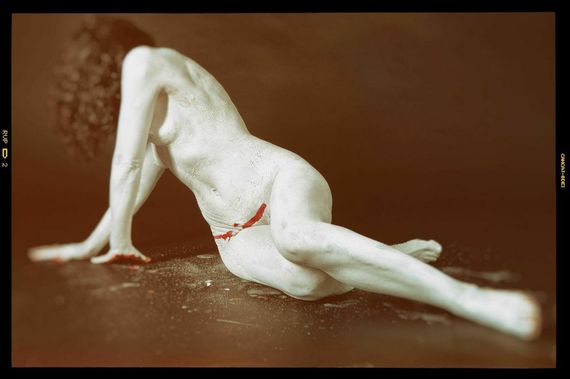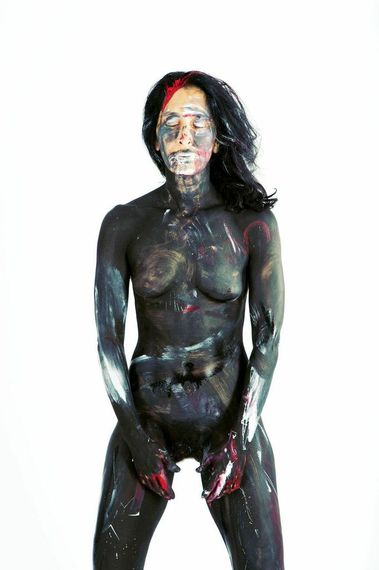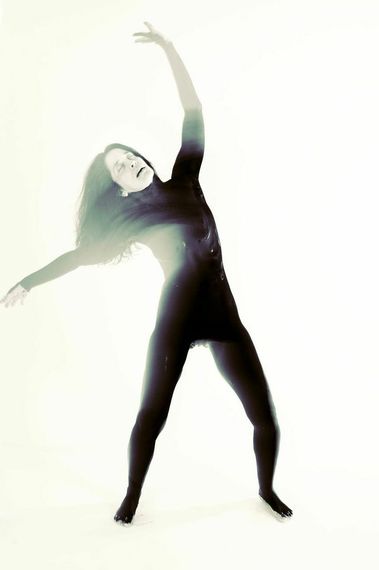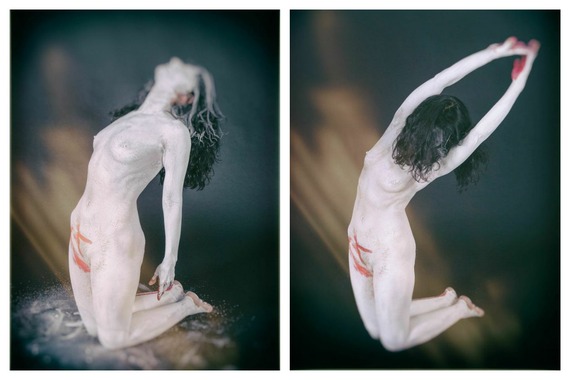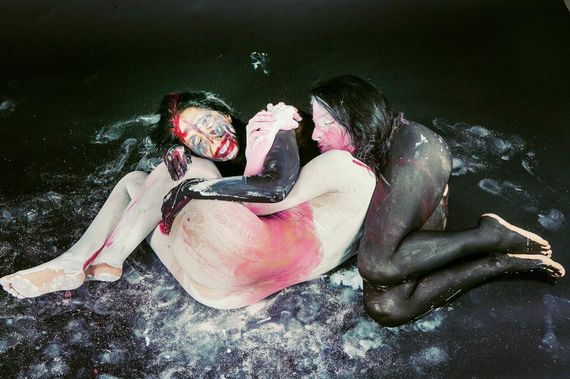Note: Some of the images below may be considered not safe for work.
When 48-year-old identical twins Lisanne and Colette Sartor asked to participate in my Love Your Body Now: Healing Body Image Issues Through Fine Art Nudes project, I didn't think they were suitable candidates.
The project was initially conceived to help full-bodied women struggling with body image issues in our size-0 world.
Lisanne and Colette didn't fit that mold. They've both maintained svelte, gamine figures, which elicit jealousy from women half their age.
But when Lisanne and Colette returned their questionnaires, I realized my concept of loving our bodies now was still only skin deep, because, despite outward appearances, both sisters are dealing with an extraordinary amount of pain.
"Sometimes I feel like Peter Pan. But not because I don't want to grow up. I'm like Peter Pan in that I'm chasing my shadow, only my shadow is my body." - Lisanne Sartor
Lisanne is plagued by chronic illness: gastric ulcer, abscessed Bartholyn gland, precancerous uterine cells, migraines, precancerous polyps, Crohne's Disease, Intercystial Cystitis, Sacroiliac joint dysfunction, Spondylitis, two bouts of depression and debilitating insomnia.
Colette's body shadows Lisanne's. Her ailments are similar, but less debilitating. Lisanne is the older sister by three minutes. It's as if her body has somehow served as a barrier for her sister's, taking the brunt of the pain.
Suddenly, I wondered whether the LYBN project could be a catalyst for healing trauma, so the sisters could come back to their bodies and live in them again. Which meant, more than anything, that loving our bodies now is about coming home.
Guided Body Work
LYBN body-coach Marlene Zaleznick sits cross-legged on my couch opposite Lisanne, leading her in a guided meditation.
She asks Lisanne to imagine there's a filament in the center of her womb that is like the filament in a light bulb.
Then, to imagine that filament ignited, sending light throughout her body the way a light bulb illuminates a room.
But Lisanne struggles. The Spondylitis (inflammation of the vertebrae) has flared up, stealing her focus.
Marlene asks, "Can you touch the part of your back that hurts?"
Lisanne tentatively obeys, her movements slow, cautious, like the movements of a much older woman.
"What is your back saying?" asks Marlene.
Lisanne closes her eyes, takes a moment to consider.
"Busy, busy, busy," she says, "Busy like a bee. Whenever I'm afraid, I go to busy and angry."
"Take a peek at the fear. What's the fear about?" Marlene asks.
"It's always the fear of failure."
"What if you touched your back as though you loved it?"
"It's hard to love," Lisanne says. Then somberly, "I feel like it's failed me."
Later, Marlene works with Colette asking her to have compassion for the parts of her body that aren't working properly.
"What would it feel like," Marlene softly queries, "to have compassion for your body?"
"Self-indulgent," Colette asserts unequivocally. "The men in our family always say if you want to play with the Big Dogs, you can't piss like a puppy. Self-compassion is pissing like a puppy."
The Third Body
Lisanne and Colette were raised in New Jersey by Italian-Catholic parents who laughed as hard as they fought, at least in the beginning.
In time the arguing over-shadowed the laughter, rendering it obsolete.
The defining trauma of the twins' childhood was their mother's weight, which sometimes rocketed to almost 400 pounds, and the family's disappointment in her.
The sisters intuitively knew that their morbidly obese mother, who'd given up her academic studies to marry and have children, was "pissing like a puppy" in their family's eyes.
From a young age, the twins fought to be the antithesis of their mom and were driven to succeed academically (they collectively graduating from UCLA, Yale, Harvard and The Iowa Writer's program) and professionally.
The sisters were running with the Big Dogs. But it wasn't enough. They also had to stay thin.
Colette spent much of her 20s and 30s running six miles a day, six days a week.
Lisanne took up swimming. "Never one to do anything half-assed," she said," I quickly went from swimming 10 laps a day to swimming two miles a day, six days a week.
"I remember toweling off after a workout and someone asking me how many laps I'd swum. When I told her 110, she gasped. I'd always prided myself on being thin (don't be like your mother, don't be like your mother), as if it were my greatest asset."
"The chronic illnesses I was first exposed to," Lisanne wrote, "were my mother's. Her eating disorder and her depression."
Lisanne and Colette's mother died of complications from morbid obesity on April 27, 2013.
Although their mother is gone, the relationship she had with her body still reverberates in the twins' bodies today.
The Shoot
The day after Marlene's bodywork sessions, our group, which includes gifted photographer Beth Sanders, meets at a rented photographic studio in the Flower Market District of downtown Los Angeles for the shoot.
Colette stands, painted starkly black against a white backdrop.
As Beth begins to shoot Colette, Marlene continues to work with her. She asks Colette to say, "I am beautiful."
"Do I have to?" Colette grimaces.
"Yes!" Marlene insists.
"I am beautiful," Colette says, as if she's tasted glue.
"When you said that, where did it come from?" Marlene asks.
Colette points to her head. "Up here."
I'm struck by something. "Maybe it wasn't okay to be beautiful, when your mother wasn't?" I query.
Colette and Lisanne both say that their mother was stunning when she was young and thin, more beautiful than they are now. But when people first met their mother when she was obese, the sisters often saw shock in their eyes. After one of Lisanne's boyfriends met their mom for the first time he said, "That is your mother?"
Colette's face fills with pain. "Once we were older, no one said my mother was beautiful. So we couldn't be."
"Let's come back to your body," Marlene instructs her. "When did you feel most connected to your body?"
Instantly, Colette's face lights up.
"When I was singing. To sing properly you have to sing from your core."
Colette indicates the same place in her body that Marlene has been guiding her back to again and again during body meditation, the center of her diaphragm.
Colette tells us how much she loved singing, but that she doesn't do it anymore.
"Why'd you give it up?" Marlene asks.
"I got to a stage in my development as a singer where I knew I couldn't get any better. And that I just wasn't good enough, that I couldn't make a real living at it."
"You don't sing anymore at all?" queried Beth.
Colette seems almost shy, as if admitting an embarrassing secret. "I sing to my son when I put him to bed. But that's the only time."
"Look at the pain you're feeling right now as if it were a small child," says Marlene. "Embrace it. Sing what wants to come up."
I worry Colette doesn't want to sing, that we're asking too much.
"What lullaby would come up if you were to sing to a child?"
Colette opens her mouth, and from the base of some primal well her voice emerges in a wordless lullaby. My arms are covered in gooseflesh as Beth's shutter snaps away.
Colette's voice is lush, gorgeous and, I can't help thinking, this song is an elegy to the mother who haunts her still.
Lisanne, her nude body painted completely white, with thin lines of red paint demarking all of the places that pain her, stands against the black paper backdrop, stiff, guarded, as if girding herself for an invasion.
Lisanne was surprised Beth wanted to paint her white.
She jokingly said she's the darker of the sisters, so she should be the one painted black.
Lisanne is still angry that her parents often treated her like an adult, confiding things they shouldn't have to a child and sometimes even using her as a mediator between them.
It's this anger that makes her seem tougher and stronger than Colette. But Beth sensed Lisanne's "exquisite sensitivity" and sadness, which she thought the white paint might bring out.
As Beth begins shooting Lisanne, her back spasms and begins to throb.
We'd learned during Marlene's workshops that the more Lisanne runs from her fear of failure, the more she abandons her body. And, in turn, the more her body fails her.
"I was always afraid of doing a bad job, of being a failure, of not being able to hold my own with the Big Dogs. So afraid that I sacrificed my health and happiness," says Lisanne.
Beth instructs her to move into poses that relieve the pain in her back. I'm struck by the beauty of her poses, how they seem to evoke grief, anger and letting go:
When the sessions end, four hours later, all of us are simultaneously exhilarated and spent.
Presenting The Photos
Two days later Beth, Marlene and I meet with the sisters for the last time to present their photos to them, which they love.
Marlene asks the sisters to check in with their bodies, to come into a meditative state.
She asks if they can think, for a moment, about their mother and how they didn't feel they could be beautiful because no one told their mom she was beautiful.
"Could you think that when you are beautiful it is for your deceased mother? That you are honoring and healing the lineage of body hatred and shame for her?"
Both women have such mixed emotions about their mom. Love. Loyalty. Fierce protectiveness. Sadness. Anger. Regret.
Lisanne writes beautifully about the time she realized her mom was more than just her mother, but a person in her own right.
I wore my mom's wedding dress when I got married. One day, my mom and I were talking about my wedding video, which she'd just watched. She told me that during the father-daughter dance, she'd gotten confused and wondered where in the hell I was and why she was dancing with my dad? And then she realized it was me, not her, dancing with my dad in her wedding dress. She cried as she told me and I realized for the first time in my whole life that when my obese mother looked in the mirror she still saw the thin woman she'd been when she got married. Or the vestiges of that woman. And missed her.
The story of these three bodies doesn't end here. It's the journey of a lifetime. But my hope for Lisanne and Colette is that more and more often they will love and inhabit their bodies.
That more frequently than not, it will be possible to come home.
To read the unabridged version of this story and see more of the photos CLICK HERE.

